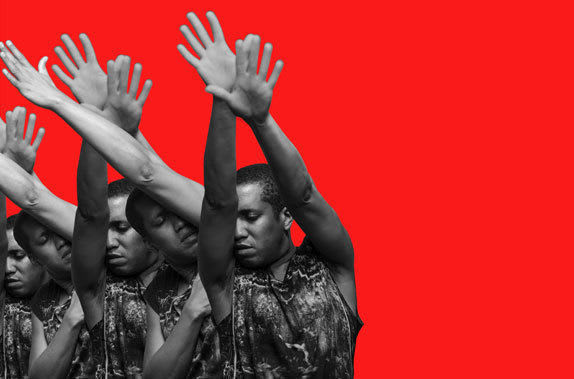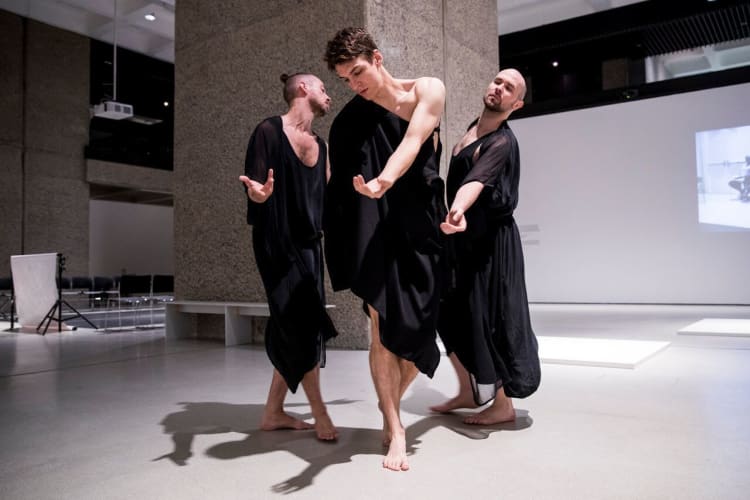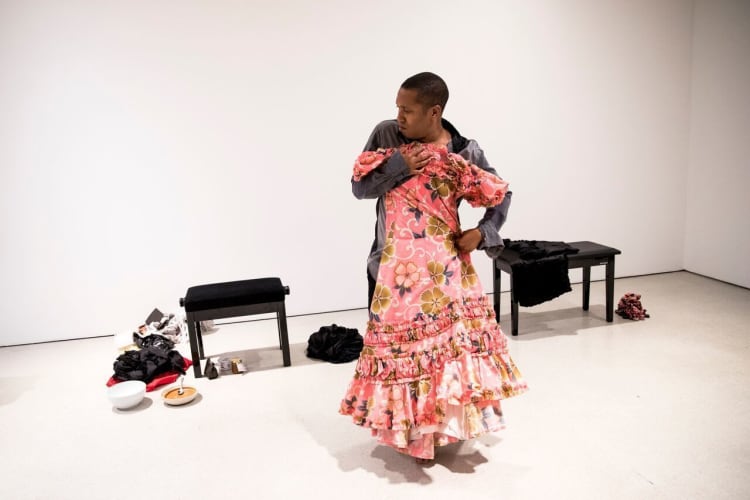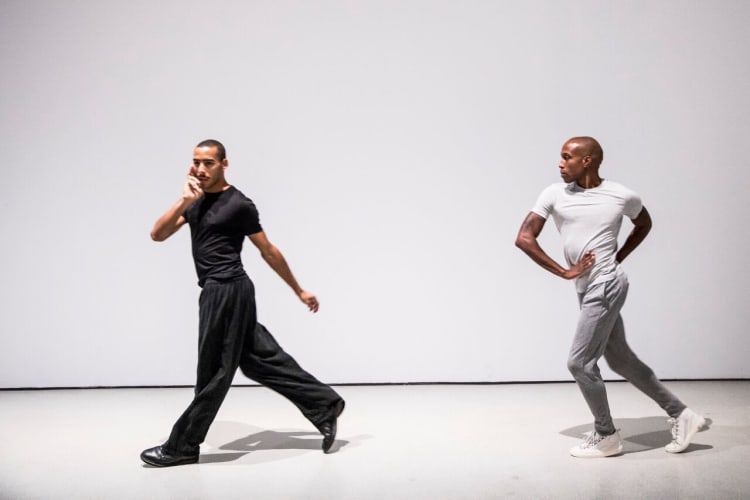This is an immersive exhibition incorporating live performance and video that draws on the very varied work of American choreography and performer Trajal Harrell over nearly two decades to create a complex and ongoing work that presents 14 of his creations showing the great range of his creativity.
Visitors are free to wander through the exhibit choosing what to watch and for how long among performances that may be happening simultaneously. A listing of timings will be made available for each day’s performances (which are Thursdays to Sundays only). They encounter a variety of dance forms that range from Japanese butoh to Harlem voguing, from the showy to the decidedly minimal. Some of the 16 performers, who include Trajal Harrell himself, are drawn from his regular collaborators, others have been cast in London and there is role swapping for different timings.
Each work centres on a particular part of the gallery. Titles on walls name what will be performed nearby with some information about it and suitable environments have been created. For some, this is simply a space in the middle of the area, a path against a wall or perhaps incorporates a flight of stairs.
Perhaps there is a raised slab of white on the floor, elsewhere there are images projected onto such areas, bordered with decorative braiding, chairs may be set out, in one case a room without light has to be entered and for recent work Caen Amour (2016) a double-sided setting has been constructed with a performance platform and a domestic-looking artistes' area where their preparations to appear also become part of the performance.
Caen Amour takes its inspiration from the “hoochie koochie” shows that were part of American travelling fairs through most of the twentieth century and developed by dancers imitating the exotic “oriental” style of dancer Little Egypt at the 1893 Chicago World Fair. This performance of an extract from the hour-long work references both hoochie koochie eroticism for the male gaze and modern fashion show.
A solo dancer (Harrell himself at the press performance) prances before us, air punches, works his hips, waves fluid arms, reaches out in longing, clenches fists in a sequence that seems to have an internal story.
This is followed by a succession of entrances in which both male and female dancers parade items of clothing, not worn but held in front of them, figures with heads and bodies wound in sari-like fabric and a crouching, tongue-lolling, mad creature that could reference Koschei's creatures in Firebird. Shadows of the performers appear on a window screen and behind the scenes you can watch their quick-changes and the semi-nudity of catwalk backstage.
Bathing Suit (an extract from 2008’s The Quartet at the End of Time) presents a girl in a bikini whom you follow into a dark room where, lit behind gauze, she lies on the ground like a victim before lifting her costume off her body to reveal her nakedness and then meticulously folding it, laying its strings precisely before disappearing into the darkness.
In The Untitled Still Life Collection (2011, developed with visual artist Sarah Sze) two dancers (I saw it with both two girls and a mixed pair) approach each other with ultra-slow, butoh-like movement and they interact with a long piece of cord. They may use to link mouth to mouth like stretched-out gum or one wraps the cord around the other, a mixture of choreography and living sculpture.
Voguing is a recurrent feature. In It is Thus, a lone dancer treats the space like a catwalk, slowly advancing in a straight line, posing with artificial elegance and full of their own celebrity. In Wall Dance, a pair of dancers vigorously patrols close to a wall to a loud beat, sometimes following, sometimes facing each other as they strut in rhythmic unison. In Let’s Get Sick, the voguing is wilder as a pair of dancers range through various spaces and up stairs. Creon Solo is an on the spot solo, a dancer semi-clothed in what look like Hermes scarves.
Harrell creates mash-ups that may confront fragments of dance history with contemporary culture or merge them. The Return of La Argentina (2015) is a strange work inspired by his archival research into butoh, a fictional recreation of a 1977 solo by Kazuo Ohno dedicated to a famous Spanish dancer. Much easier to respond to is Show Pony in which, with his audience sitting on two rows of chairs, he moves along them, interacting. Sometimes he will sit on a lap, gaze into eyes, whisper in ears, lie across two sets of legs, or take over empty spaces. It is extremely intimate and strangely moving.
The work on show furthest from ideas of conventional dance is The Performance of Conspiracy in which two performers read out Jean Baudrillard’s essay The Conspiracy of Art, each passage in alternate French and English translation and with the word Art changed into performance.
In contrast, and mesmeric in a very different way, is Ghost Trio in which three dancers approach each other and, after one exchange of looks, seem to enter their own worlds as they fluidly circle around each other, interweaving limbs. It is very beautiful and certainly my favourite work in this intriguing show. Its intricate poses are very different from catwalk voguing but there is a connection.
Vogue poses in the fashion world come with an aggressive arrogance but that is not a dominant feature of Harrell’s work. His own style, especially, is much gentler, more sensitive and, though the energy of some pieces may make the performer confrontational, that energy seems to come from enthusiasm and enjoyment, not aggression.
Whatever the influences, Harrell is making work that is very much his own and this is an excellent opportunity to experience it.



